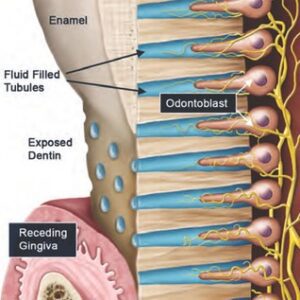Dentine hypersensitivity/ tooth sensitivity is one of the common complaints in dentistry. Studies show that 60% of the population experience the discomfort of tooth sensitivity and describe this discomfort as a short, sharp pain in response to external stimuli: theraml, tactile, osmotic, evaporative or chemical .
Dentine hypersensitivity can be triggered / increased by cold, air pressure, dryness, sugar, sour (any dehydrating chemicals) or forces acting onto the tooth (pressure when you bite your teeth together or during dental treatment). Hot or cold food / drinks and brushing your teeth (physical pressure) are typical triggers in those individuals with sensitive teeth.
Dentine hypersensitivity arises from  exposed dentine. Dentine contains many thousands of microscopic tubular structures that radiate outwards from the nerve of the tooth (pulp). Dentine is covered by two tooth structures: enamel and cementum. Enamel is the hardest outer surface of the tooth crown and it protects the sensitive dentine underneath. Cementum is the protective structure of the root/roots. When these two structures are damaged that will subsequently cause the exposure of the dentinal tubules. Gingival recession is also associated with the development of dentine hypersensitivity; the exposure of roots, which follows recession, can result in a loss of the cementum layer.
exposed dentine. Dentine contains many thousands of microscopic tubular structures that radiate outwards from the nerve of the tooth (pulp). Dentine is covered by two tooth structures: enamel and cementum. Enamel is the hardest outer surface of the tooth crown and it protects the sensitive dentine underneath. Cementum is the protective structure of the root/roots. When these two structures are damaged that will subsequently cause the exposure of the dentinal tubules. Gingival recession is also associated with the development of dentine hypersensitivity; the exposure of roots, which follows recession, can result in a loss of the cementum layer.
A lot of other conditions can also cause teeth sensitivity, so it is important that you visit your dentist to make the correct diagnosis and treat you appropriately.
